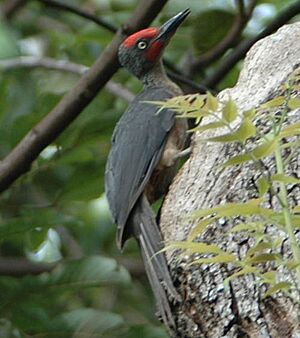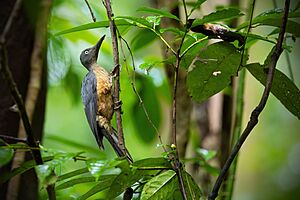Ashy woodpecker facts for kids
Quick facts for kids Ashy woodpecker |
|
|---|---|
 |
|
| Male Mulleripicus fulvus fulvus | |
 |
|
| female | |
| Conservation status | |
| Scientific classification | |
| Genus: |
Mulleripicus
|
| Species: |
fulvus
|
The ashy woodpecker (Mulleripicus fulvus) is a type of bird from the woodpecker family. It lives only in Sulawesi and nearby islands in Indonesia. This bird is known for its unique look and how it finds food.
Contents
Where Do Ashy Woodpeckers Live?
Ashy woodpeckers are found only in Sulawesi, an island in Indonesia, and the small islands around it. When a species lives only in one place, it is called endemic. They like to live in tropical forests. You can find them in both lowland forests and forests high up in the mountains.
These birds prefer thick, untouched forests. However, they can also live in forests that have grown back after being cut down. Sometimes, they even live in small patches of forest found in grassy areas. Ashy woodpeckers do not move to different places for the seasons. They stay in the same area all year round. You can spot them from sea level up to about 2,000 meters (6,560 feet) high.
There are two main types, or subspecies, of the ashy woodpecker. One type, M. f. fulvus, lives in northern Sulawesi and islands like Lembeh and Togian. The other type, M. f. wallacei, lives in southern Sulawesi and islands like Muna and Buton. This second type is named after a famous scientist, Alfred Russel Wallace.
What Does an Ashy Woodpecker Look Like?
The ashy woodpecker is a large bird, growing to about 40 centimeters (16 inches) long. Male and female ashy woodpeckers look a little different.
- Males: The male has a bright red face that goes up to the middle of its head. The back of its head and neck are grey. Its throat, the front of its neck, and its belly are a light tan color. The rest of its back and wings are grey-brown or dark grey. It has a long black beak and yellow eyes. A grey ring surrounds its eyes.
- Females: The female looks similar to the male. However, her head is completely grey. It might have faint spots, but not on the forehead.
The M. f. wallacei subspecies has more red on its face than the other type. The red covers most of its head. This subspecies also has a slightly longer tail and wings. Its beak, however, is a bit shorter.
Ashy woodpeckers make interesting sounds. They have calls that sound like laughing, such as "hew-hew-hew-hew-hew." They also make "tuk tuk tuk" sounds. These calls are soft, not very loud. During the time they are looking for a mate, they also make drumming sounds.
What Do Ashy Woodpeckers Eat?
Ashy woodpeckers mostly find their food on trees. They often climb on tree trunks looking for a meal. They also sometimes break into termite nests found on the ground. Their diet includes termites, caterpillars, and other insects and small creatures with many legs, like spiders.
Ashy Woodpecker Nests and Babies
Scientists do not know much about how ashy woodpeckers build their nests. One time, a pair was seen digging a nest hole. The male bird did most of the digging work. They make their nest holes in dead trees. They might also use dead parts of living trees. Female ashy woodpeckers usually lay two to three eggs.


